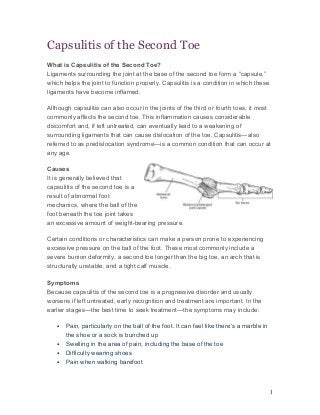
Capsuliti
- 1. Capsulitis of the Second Toe What is Capsulitis of the Second Toe? Ligaments surrounding the joint at the base of the second toe form a “capsule,” which helps the joint to function properly. Capsulitis is a condition in which these ligaments have become inflamed. Although capsulitis can also occur in the joints of the third or fourth toes, it most commonly affects the second toe. This inflammation causes considerable discomfort and, if left untreated, can eventually lead to a weakening of surrounding ligaments that can cause dislocation of the toe. Capsulitis—also referred to as predislocation syndrome—is a common condition that can occur at any age. Causes It is generally believed that capsulitis of the second toe is a result of abnormal foot mechanics, where the ball of the foot beneath the toe joint takes an excessive amount of weight-bearing pressure. Certain conditions or characteristics can make a person prone to experiencing excessive pressure on the ball of the foot. These most commonly include a severe bunion deformity, a second toe longer than the big toe, an arch that is structurally unstable, and a tight calf muscle. Symptoms Because capsulitis of the second toe is a progressive disorder and usually worsens if left untreated, early recognition and treatment are important. In the earlier stages—the best time to seek treatment—the symptoms may include: • Pain, particularly on the ball of the foot. It can feel like there’s a marble in the shoe or a sock is bunched up • Swelling in the area of pain, including the base of the toe • Difficulty wearing shoes • Pain when walking barefoot 1
- 2. In more advanced stages, the supportive ligaments weaken leading to failure of the joint to stabilize the toe. The unstable toe drifts toward the big toe and eventually crosses over and lies on top of the big toe—resulting in “crossover toe,” the end stage of capsulitis. The symptoms of crossover toe are the same as those experienced during the earlier stages. Although the crossing over of the toe usually occurs over a period of time, it can appear more quickly if caused by injury or overuse. Diagnosis An accurate diagnosis is essential because the symptoms of capsulitis can be similar to those of a condition called Morton’s neuroma, which is treated differently from capsulitis. In arriving at a diagnosis, the foot and ankle surgeon will examine the foot, press on it, and maneuver it to reproduce the symptoms. The surgeon will also look for potential causes and test the stability of the joint. X-rays are usually ordered, and other imaging studies are sometimes needed. Non-surgical Treatment The best time to treat capsulitis of the second toe is during the early stages, before the toe starts to drift toward the big toe. At that time, non-surgical approaches can be used to stabilize the joint, reduce the symptoms, and address the underlying cause of the condition. The foot and ankle surgeon may select one or more of the following options for early treatment of capsulitis: • Rest and ice. Staying off the foot and applying ice packs help reduce the swelling and pain. Apply an ice pack, placing a thin towel between the ice and the skin. Use ice for 20 minutes and then wait at least 40 minutes before icing again. • Oral medications. Nonsteroidal anti-inflammatory drugs (NSAIDs), such as ibuprofen, may help relieve the pain and inflammation. • Taping/splinting. It may be necessary to tape the toe so that it will stay in the correct position. This helps relieve the pain and prevent further drifting of the toe. • Stretching. Stretching exercises may be prescribed for patients who have tight calf muscles. 2
- 3. • Shoe modifications. Supportive shoes with stiff soles are recommended because they control the motion and lessen the amount of pressure on the ball of the foot. • Orthotic devices. Custom shoe inserts are often very beneficial. These include arch supports or a metatarsal pad that distributes the weight away from the joint. When is Surgery Needed? Once the second toe starts moving toward the big toe, it will never go back to its normal position unless surgery is performed. The foot and ankle surgeon will select the procedure or combination of procedures best suited to the individual patient. 3
- 4. Dr. Nigro Foot and Ankle Care Centers The Best Available Care; Trusted by Doctors and Preferred by Patients http://www.PittsburghFootAndAnkle.com Call any of our Four Office Locations for an Appointment Main Office (Vandergrift) 127 Columbia Ave, Vandergrift, PA 15690 Phone: (724) 567-7520, Fax: (724) 568-2169 Glenshaw Office 922 Garden Place, Glenshaw, PA 15116 Phone: (412) 486-5100, Fax: (412) 486-5122 Natrona Heights Office 1601 Union Ave Suite B, Natrona Heights, PA 15065 Phone: (724) 226-0544, Fax: (724) 226-2172 Cabot Office Concordia Professional Building 1134 Marwood Road, Cabot, PA 16023 Phone: (724) 226-0544, Fax: (724) 226-2172
